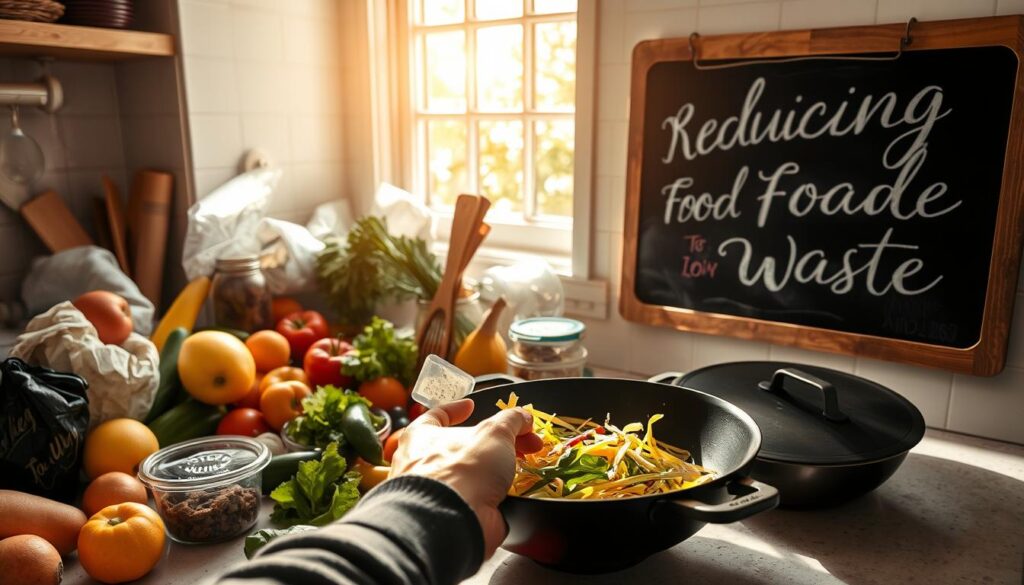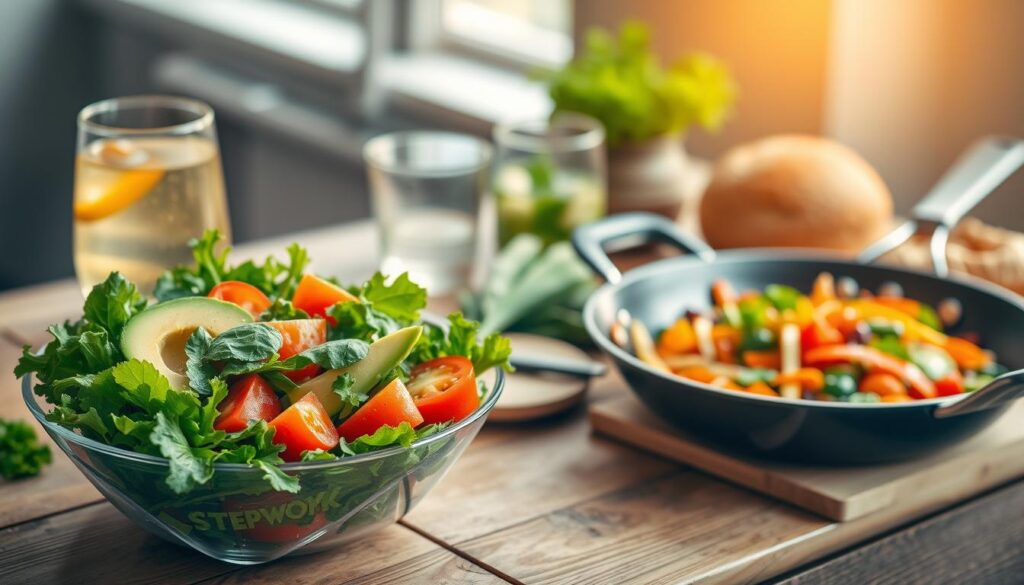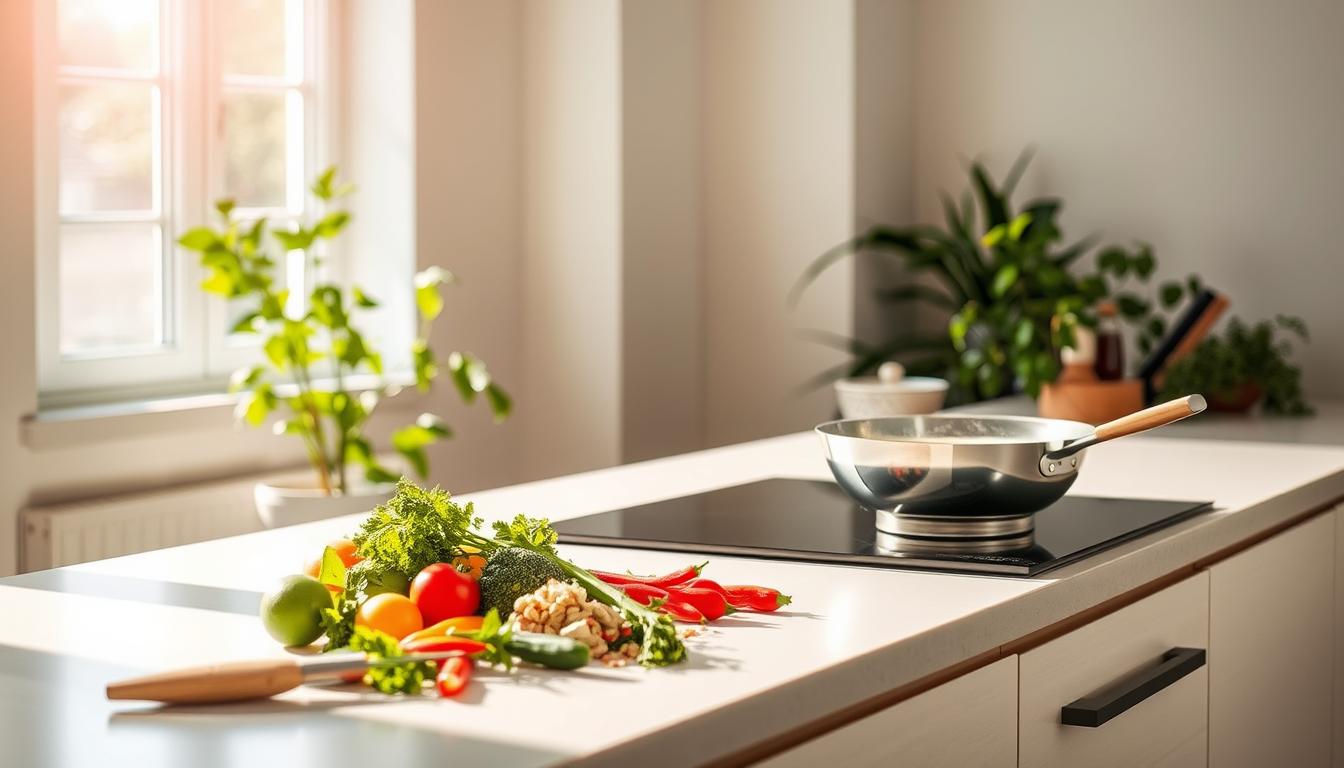We all want a healthier planet, and cooking sustainably is key. In the U.S., over a third of food is wasted. By cooking sustainably, we can cut down on waste and make our kitchens greener. Simple steps like meal planning and using leftovers help a lot.
Changing how we cook can greatly reduce waste and help us eat healthier. For example, planning meals and using leftovers can cut waste by more than 30%. Choosing local foods also helps by reducing transportation emissions. These actions support sustainable cooking and healthy lunches.
Embracing sustainable cooking benefits both our planet and our health. Families can save up to $1,500 a year by reducing food waste. This shows that sustainable cooking is good for the planet and our pockets. Let’s explore how we can make our kitchens greener and enjoy healthier lunches.
Key Takeaways
- Adopting sustainable cooking practices can help reduce food waste and promote healthy eating habits, contributing to a greener kitchen and a healthy lunch.
- Meal planning and utilizing leftovers can cut a household’s food waste by over 30%, making it a key component of sustainable cooking practices.
- Choosing local ingredients can help reduce the environmental impact of transportation, supporting sustainable cooking practices and a healthy lunch.
- Reducing food waste can lead to significant savings, with the average family of four able to save around $1,500 per year, while enjoying sustainable cooking practices and a healthy lunch.
- By making a few simple changes to our cooking habits, we can create a greener kitchen and make a positive impact on the environment, while enjoying a healthy lunch through sustainable cooking practices.
- Sustainable cooking practices are essential for reducing waste and promoting healthy eating habits, and can be achieved through simple habits such as meal planning and choosing local ingredients, resulting in a healthy lunch.
- By embracing sustainable cooking practices, we can make a positive impact on the environment and our health, while enjoying a healthy lunch and creating a greener kitchen.
Understanding Sustainable Cooking Practices
Sustainable cooking is key to a greener kitchen. It involves using eco-friendly recipes and methods. This way, home cooks can lessen their environmental footprint.
Using ingredients, methods, and tools that save resources is part of it. This approach helps reduce waste and conserve nature.
The United States Environmental Protection Agency says food waste is 20% of landfill waste. Sustainable cooking, like using reusable items and choosing local foods, helps. It also cuts down on waste.
- Reducing greenhouse gas emissions from food preparation and distribution
- Conserving natural resources such as water, soil, and energy
- Supporting local economies by choosing locally sourced produce
By making sustainable cooking a part of their daily life, home cooks help the planet. They make their kitchens more eco-friendly and contribute to a healthier world.
Choosing Local Ingredients
Creating a green kitchen means making smart choices about what we cook with. Choosing local ingredients is a great way to do this. It helps local farmers and cuts down on emissions, making our planet healthier. Plus, eating seasonal produce means we get fresher, better food and help the environment.
Some benefits of choosing local ingredients include:
- Reduced transportation emissions
- Support for local farmers and the local economy
- Fresher, more nutritious produce
Using local ingredients in our meals can really help the planet. Simple changes in how we cook can make a big difference. It’s a step towards a more sustainable food system.
For those wanting to help the environment, start small in the kitchen. Pick local ingredients and make sustainable meals. This way, we can enjoy healthy lunches and support a greener kitchen.
As we learn more about sustainable cooking, we’re all choosing better. We’re looking for local ingredients and eco-friendly products. These choices help us build a greener future.
| Benefits of Local Ingredients | Environmental Impact |
|---|---|
| Reduced transportation emissions | Lower carbon footprint |
| Support for local farmers | Healthier planet |
| Fresher, more nutritious produce | Improved food quality |
Reducing Food Waste
Reducing food waste is key to eco-friendly cooking. In the U.S., about 30% to 40% of food is wasted. This adds up to around 133 billion pounds each year. Most of this waste comes from households, mainly during food prep.
To cut down on waste, smart meal planning is vital. Plan meals ahead, make a shopping list, and avoid buying too much. Also, using leftovers can save money and reduce waste. Here are some ideas:
- Make a soup or stir-fry with leftover veggies
- Turn last night’s dinner into tomorrow’s lunch
- Freeze leftovers for later meals
By using these tips, we can greatly reduce food waste. This not only helps the environment but also saves money. As we learn more about eco-friendly cooking, cutting down on waste is essential.

Small changes in our daily habits can make a big difference. They help reduce food waste and support eco-friendly cooking.
| Food Waste Reduction Strategies | Benefits |
|---|---|
| Meal planning and grocery lists | Reduces food waste by up to 25% |
| Using up leftovers | Decreases food waste by an estimated 20% |
| Proper food storage | Helps reduce spoilage rates and extends shelf life |
Energy-efficient Cooking Methods
Using green kitchen tips and eco-friendly cooking can cut down energy use. One key way is to pick energy-saving cooking methods. The United States Department of Energy says induction cooktops are up to 90% efficient. This is much better than the 40-50% efficiency of traditional stoves.
Utilizing the Slow Cooker
Slow cookers are great for saving energy. They cook food at a low temperature for a long time. This can save up to 50% of energy compared to other cooking ways.
Slow cookers are also good for making many dishes, like stews and soups. They’re great for busy homes because you can leave them cooking without supervision.
The Benefits of Induction Cooktops
Induction cooktops are another energy-saving choice. They use less energy than standard stoves and can save up to 30% compared to gas stoves. They also cook food faster and are easy to clean.
By using these energy-saving cooking methods, you can lower your energy use. This helps make cooking more eco-friendly.
- Use energy-efficient appliances, such as slow cookers and induction cooktops, to reduce energy consumption.
- Cook meals at lower temperatures for longer periods to save energy.
- Choose eco-friendly cooking methods, such as solar ovens or microwave cooking, to reduce energy waste.
Eco-friendly Kitchen Tools
Choosing the right kitchen tools is key to sustainable cooking. Eco-friendly tools help us reduce waste and protect the environment. For example, reusable silicone bags can cut down on plastic use by a lot.
Consider using stainless steel kitchen tools for their recyclability. Cast iron cookware also offers a durable, non-stick option when seasoned right. Plus, silicone baking mats can save a lot of aluminum foil and paper.
Here are some benefits of using eco-friendly kitchen tools:
- Reduce plastic waste by using reusable containers and bags
- Lower the risk of exposing food to harmful chemicals by using non-toxic ceramic-coated cookware
- Save energy and resources by using eco-friendly stove options, such as induction cooktops
Using eco-friendly tools makes our kitchens healthier and greener. It encourages us to try more sustainable recipes and live greener lives.
| Eco-friendly Kitchen Tool | Benefits |
|---|---|
| Reusable silicone food storage bags | Replace around 500 single-use plastic bags over their lifetime |
| Stainless steel kitchen tools | Recyclable and eco-friendly alternative to non-stick cookware |
| Cast iron cookware | Create a natural non-stick surface when properly seasoned |
Plant-based Lunch Alternatives
Plant-based options are great for a healthy lunch. They’re good for your health and help the planet. By choosing plant-based meals, you support a sustainable lunch recipes and a green kitchen.
A green kitchen is about more than just food. It’s about how you cook it too. Using energy-efficient appliances and cutting down on waste are key. You can plan meals, use leftovers, and compost to reduce waste.
Here are some benefits of a plant-based diet:
- Reduced risk of heart disease
- Lower greenhouse gas emissions
- Increased food sustainability
Small changes can make a big difference. Try more plant-based meals and reduce waste. This will help you and the planet.

Mindful Grocery Shopping
Mindful grocery shopping is key to eco-friendly cooking and cutting down on food waste. Planning meals and making a list helps the environment and saves money. The National Resources Defense Council says using reusable bags and containers cuts waste and costs.
Creating a Sustainable Grocery List
Creating a sustainable grocery list means planning meals and listing must-haves. This cuts down on waste and saves cash. Here are some tips:
- Plan meals for the week
- Make a list of essential items
- Avoid buying on impulse
The Impact of Packaging Choices
Packaging choices greatly affect the environment. Opting for items with less packaging and avoiding single-use plastics reduces waste. Using reusable bags and containers has many benefits:
- It cuts down on waste and saves money
- It lessens our need for single-use plastics
- It helps lessen the environmental impact of food production and transport
By following these green kitchen tips and being mindful of how we shop, we can positively impact the environment. This reduces our environmental footprint.
Sustainable Cooking Practices with Kids
Getting kids involved in cooking can change their eating habits and help the planet. By teaching them eco-friendly recipes and sustainable cooking methods, we foster a healthy relationship with food. This also helps reduce waste.
In a green kitchen, kids learn about using local ingredients and saving energy. By cooking together, they gain skills and feel responsible for the environment.
- Planning meals together and making a grocery list
- Teaching them about different types of sustainable cooking methods, such as scratch cooking and plant-based proteins
- Encouraging them to help with meal prep and cooking
Teaching kids about sustainable cooking and involving them in cooking makes our kitchens greener. It benefits both them and our planet.
Recipes for Eco-friendly Lunches
Let’s wrap up our look at sustainable cooking with some tasty, eco-friendly lunch ideas. Wholesome
grain bowls
are filled with whole grains, fresh veggies, and plant-based proteins. They’re not just good for you, but also for the planet.
For a quick, satisfying meal, try a
fresh vegetable wrap
with crunchy greens, colorful veggies, and a tasty dressing. These wraps are great for using up leftover veggies and cutting down on waste.
To complete your sustainable lunch, blend up a
nutritious smoothie
with seasonal fruits and leafy greens. These drinks are full of vitamins and minerals. They also help you eat more plant-based foods, making your kitchen greener.
By choosing thesehealthy lunchrecipes andsustainable lunch recipes, you can enjoy tasty,eco-friendly cooking. It’s good for you and the planet. Remember, every small step towards a greener kitchen helps a lot over time.

